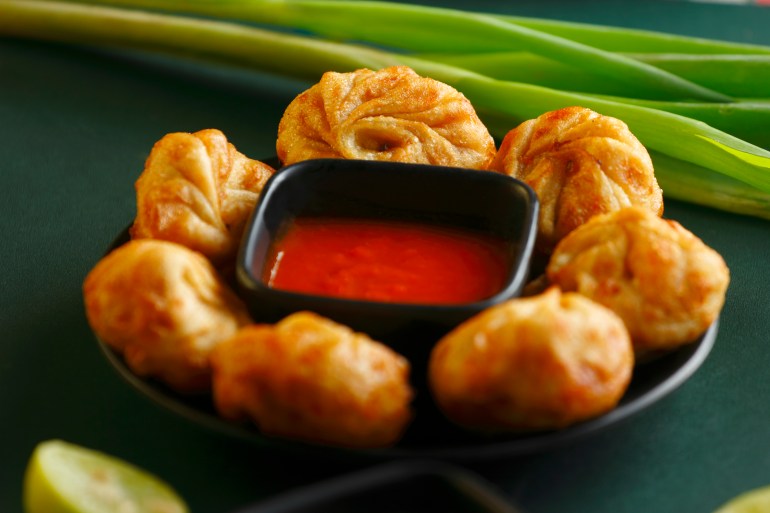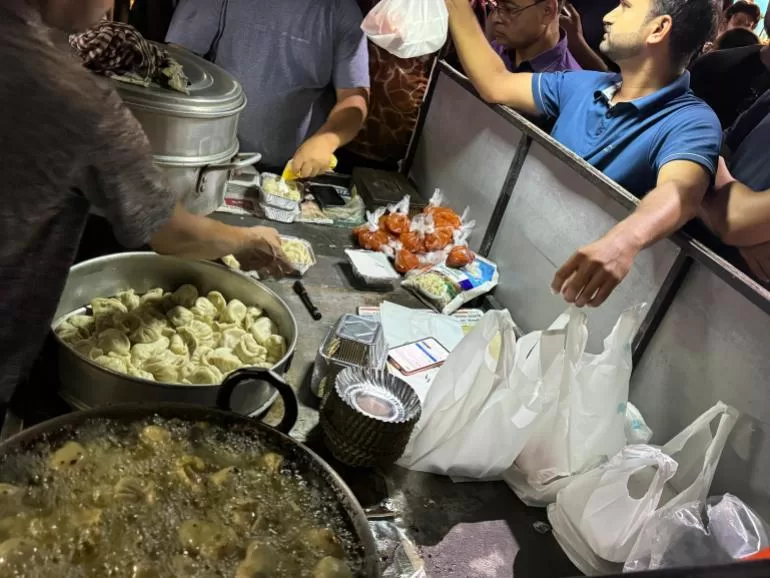Delhi, India – Sonakshi Verma, a college student, pushes her way to order a plate of momos from a corner shop on a busy market street in Delhi. The noisy shop, which opens only in the evenings, is crowded with people eagerly anticipating their first bites of one of India’s most popular street foods.
“Ek plate veg momos, bhaiya” (“Please give me a plate of vegetarian momos”), Verma says, trying to get her voice heard above the crowd.
When Verma gets her plate, she walks to a table and looks longingly at the four soft, plump dumplings nestled beside some chutney and mayonnaise.
She delicately dips one momo in the red chilli chutney, closes her eyes, breathes deeply and takes a bite. The tender outer layer tears, giving way to the savoury filling: a delicious mixture of sharp onion and garlic and spicy umami flavour. After eating two, she pauses before telling me: “I am fighting the craving to eat and at the same time just be comforted with their presence.”
I look around at the crowd of mostly students and young adults. At another table a small girl sitting with an older woman spots a man and boy heading towards their table and shouts: “Dadi momo mil gaye!” (“Grandma we got the momos!”). Soon the family are devouring two plates of the popular snack.
Momos are a steamed or fried variety of dumplings: dough-wrapped pockets of spiced vegetables or meat, served with a variety of sauces, gravies and condiments. After making their way to India, the simple and satisfying snack has become a favourite throughout the country, whether as a comfort food or celebratory dish.
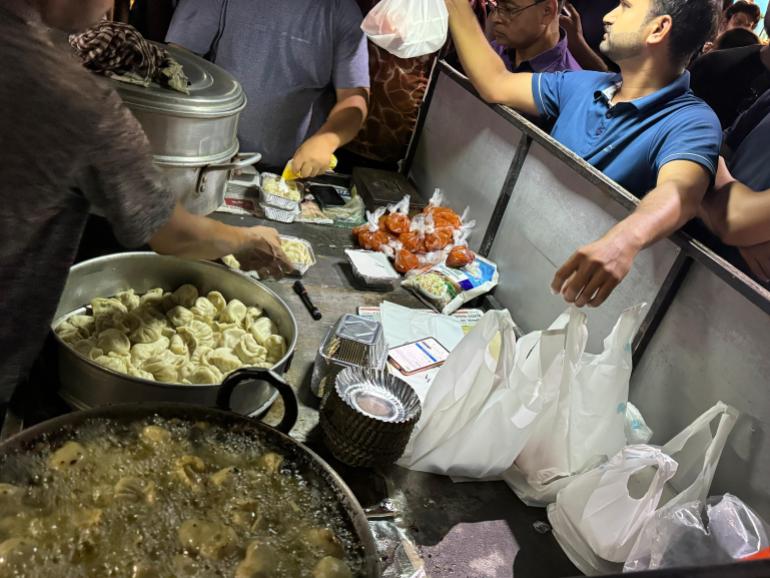
Momos are dumplings; not all dumplings are momos
Not much is known about the origin of the humble momo. “Momo has always been a part of the Himalayan region,” explains Kurush F Dalal, an archaeologist and culinary anthropologist. “Almost all the communities that live across the middle and higher Himalayas and the Tibetan plateau have all made dumplings that we call momos today.” The tradition of dumplings stretches from Europe to China, he adds.
However, he offers this important caveat: “Every single momo is a dumpling, but every single dumpling is not a momo.” Momos are a subclass of dumplings.
The dumpling difference comes down to the casing and the fillings. Dumplings (dim sums in particular) use a combination of flours – like rice, potato starch or cornstarch – for the dough. When it comes to the fillings, dumplings have been elevated to an art form with endless options, explains Rushina Munshaw-Ghildiyal, a culinary expert and corporate food consultant. Momos on the other hand are more rustic. The dough is made from all-purpose flour, which makes the momos appear more opaque, and fillings typically include a base of ginger, garlic and onions.
Dalal suspects that momos originated in Tibet – “momo” is a Tibetan word. However, the trans-Himalayan food is also eaten in Nepal, Bhutan, and the Uttarakhand and Himachal Pradesh states of India. “Food travels the same highways as trade does. As traders travel. their food travels with them,” says Dalal. The Newari community of Nepal have been trading with the Tibetans for centuries. Their momos tend to be filled with lamb and mutton.
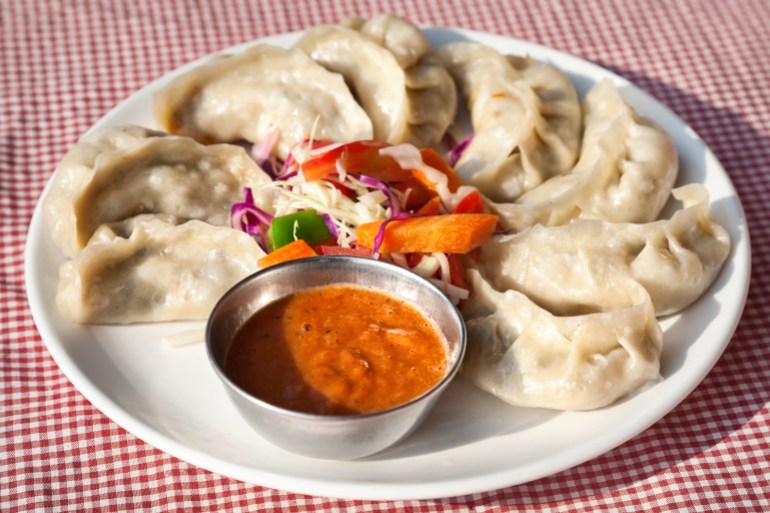
The momo takes over India
Momos arrived in Kolkata with Tibetan refugees who fled China in 1960, Dalal explains. In the previous year, the Dalai Lama escaped to India. Today, the country is home to the world’s largest Tibetan diaspora, an estimated 80,000 people.
One of the most well-known momo sellers, “Tibetan Delight” – a shop that still exists – opened in a house in the Chowrangee area of Kolkata, Dalal says. The front of the home, where Tibetan refugee families lived, served as the shop where people could buy steamed momos, mostly pork, served on plates and eat them on nearby benches. Stale momos were fried and sold as such.
In the 1990s and early 2000s, momos became very popular in Delhi and Kolkata. Doma Wang, who came to Salt Lake, Kolkata, more than 30 years ago, was inspired by an elderly woman who sold momos from her home, and began doing the same in 1992 before opening the Blue Poppy Restaurant in 2005. Wang became so popular that she was dubbed “The Momo Queen of Kolkata” by her momo-mad patrons.
In 1994, an open-air market in New Delhi called Delhi Haat began attracting vendors from the northeast. They served momos – first pork, then chicken – and fruit beer, Dalal explains. At this time many Nepalese and Tibetans had come to New Delhi from the northeast as students, refugees and economic migrants. Not only were the immigrants enthusiastic patrons of the momo shops sprouting up across the city, their knowledge of momo-making techniques made them a ready workforce.
Indians, however, initially found momos too bland, explains Vipul Yadav, a brand manager who conducts food heritage walks in Mumbai. He recounts a second-hand story: When Dolma Tsering (known as “Dolma Aunty”), a native of Tibet, opened one of the first momo stalls in Lajpat Nagar in 1994 in Delhi, there were very few buyers.
People thought the dumplings were raw and uncooked, Yadav says, so Dolma Aunty started serving them with chutneys. “Tangy chutneys, pickles and dips form an integral part of Indian meals,” including street food, he says, adding: “People often remember the dish with the condiment served, dictating the popularity of any street shop or restaurant – and momo is no exception.”
A momo is incomplete without the red chutney, Wang explains, which is prepared by soaking dry red chillies in oil and grinding them with a little salt.

Making the perfect momo
Momos are sold on steamer carts, in corner shops and in small restaurants. Most of these shops are set up in the evenings and cater for a few hours. Typically, the snacks are eaten while standing, however, a few shops have tables and chairs for people to sit. You can expect to get a wide variety of momos in almost every Indian city and some villages, and they’re almost always served with chutneys and mayonnaise
Traditionally, momos are made from all-purpose flour kneaded with cold water and stuffed with meat. However, during the Buddha Jayanti (Buddha’s birthday) month, Tibetans eat vegetarian momos made with cabbage, onions, ginger, salt and maybe some churpi (yak cheese) as the filling, Wang explains.
The secret of making a perfect momo is its skin. “It should neither be too thick nor too thin,” Wang explains. Thin dough breaks and thick dough doesn’t taste good. The meat-to-onion ratio is key to the best-tasting momo filling.
To make preparation easier, shops tend to specialise in one or two types of momos. There are myriad flavours to choose from: veg and non-veg, cheese, paneer, jhol (soupy), gravy, Kothey, Tandoori, Hakka, Afghan, Schezwan and more.
The most popular fillings, however, are vegetables, chicken and meat. A few more unusual options include potato and cheese, mushrooms with onions, ginger garlic with green chillies and Maggi (instant) noodles. There are also sweet momos, including one that’s filled with bits of chocolate lava cake.
“Kurkure [crispy] momos are mind-blowing,” says Ghildiyal. These are rolled in cornflour, coated with cornflakes and then fried and sprinkled with chat masala (spice powder).
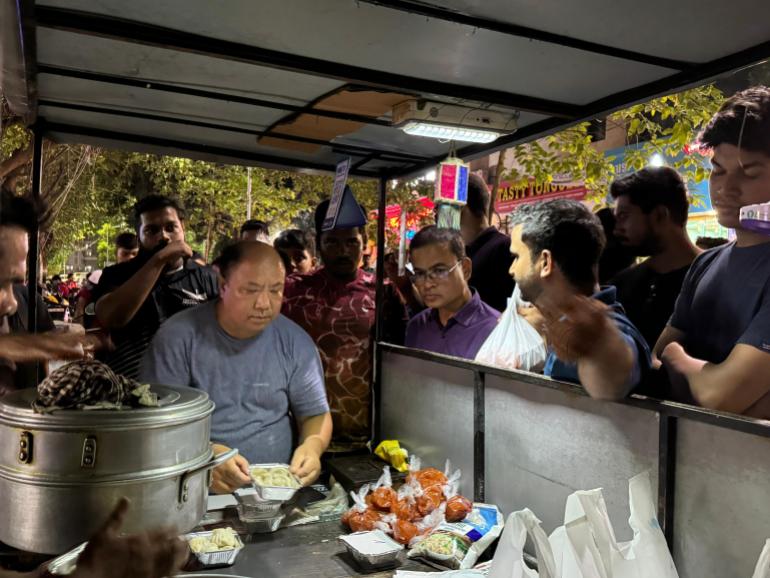
The momo effect
Momos are popular because they’re tasty, but also because they are cheap. A plate of six momos costs around 60-90 rupees ($0.72 – $1.07) making it a satisfying, pocket-friendly option.
Of course, the “tactile satisfaction a hot momo offers when eaten at the end of a day could be the main cause of its popularity as a street food”, says Ghildiyal. People relish that first bite, when the outer casing mingles with the savoury filling as the hot chutney explodes in the mouth, when the zest of garlic and chillies coats the tongue.
“Hot, salty and spicy, it is designed to be liked,” adds Ghildiyal.
And the momo is here to stay, says Prerna Kumar, founder of tea brand ChaiVeda. She has spent a lot of time researching Indian food traditions and trends. “It has become a part of Indian food just like the samosa. New flavours will get created as people experiment with local tastes.”
As Mumbai engineering student Anushka Puranik, a student of the VJTI (Veermata Jijabai Technological Institute Engineering School) in Mumbai sums up: “There is a momo for every season and every state of mind and heart … [The] strong feel-good factor is unparalleled.”
